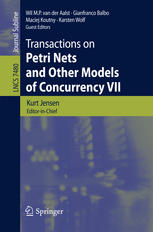

Most ebook files are in PDF format, so you can easily read them using various software such as Foxit Reader or directly on the Google Chrome browser.
Some ebook files are released by publishers in other formats such as .awz, .mobi, .epub, .fb2, etc. You may need to install specific software to read these formats on mobile/PC, such as Calibre.
Please read the tutorial at this link: https://ebookbell.com/faq
We offer FREE conversion to the popular formats you request; however, this may take some time. Therefore, right after payment, please email us, and we will try to provide the service as quickly as possible.
For some exceptional file formats or broken links (if any), please refrain from opening any disputes. Instead, email us first, and we will try to assist within a maximum of 6 hours.
EbookBell Team

5.0
98 reviewsThese Transactions publish archival papers in the broad area of Petri nets and other models of concurrency, ranging from theoretical work to tool support and industrial applications. ToPNoC issues are published as LNCS volumes, and hence are widely distributed and indexed. This Journal has its own Editorial Board which selects papers based on a rigorous two-stage refereeing process. ToPNoC contains: - Revised versions of a selection of the best papers from workshops and tutorials at the annual Petri net conferences - Special sections/issues within particular subareas (similar to those published in the Advances in Petri Nets series) - Other papers invited for publication in ToPNoC - Papers submitted directly to ToPNoC by their authors The 7th volume of ToPNoC contains revised material from the 5th International Summer School “Advanced Course on Petri Nets”, held in September 2010 in Rostock, Germany. The nine papers cover a diverse range of topics including modeling, verification, partial order semantics, and synthesis of Petri nets. In compliance with their origin as course material, the papers are written in survey or tutorial style and give a comprehensive overview of the state of the art in their respective areas.